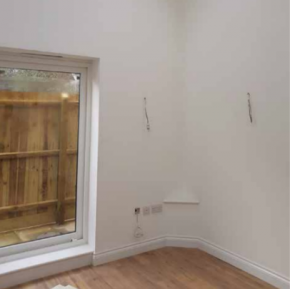
Delta Membranes provides damp proof solution for complex conversion
Delta Membranes was recently chosen to provide its extruded HDPE membrane as a solution for a complex project involving the damp proofing of a conversion of a former vehicle maintenance and repair workshop into a dwelling.
The main aim of the project was to convert a former vehicle maintenance and repair workshop into a dwelling. The workshop was of a solid wall construction (brickwork), the roof had been removed and all internal walls were painted. This project required a scope before the methodology was chosen, so Delta and MemTech Registered Installers, Anglia Property Preservation Ltd established the project objectives beforehand.
Ground tests did not reveal any significant level of Volatile organic compounds (VOC’s) in the soil but the local authority required a gas membrane to be installed and independently verified. Considering the nature of the property and the risk from ground gases, Anglia Property Preservation Ltd provided a specification combining waterproofing and ground gas remediation, as well as providing an insurance-backed installation guarantee.
A cavity drain membrane system was chosen for the damp-proofing as it offered significant advantages over the cementitious coating systems on a property such as this: old buildings are often built of masonry with lime mortar which may suffer small movement cracking over the years. This movement can sometimes be increased where alterations are carried out or cement slurry or multi-coat render tanking systems are used thereby making them at a greater risk of a defect occurring and possibly allowing water penetration to occur.
One of the main advantages of cavity drain membranes over cementitious systems is that they do not stop water at the point of entry, so hydrostatic pressure is not increased any more than it would be without a waterproofing system. Because the status quo is not altered, stresses are not induced in the substrate other than those which would be induced anyway. For this reason, it is often possible to retain substrates which would have to be replaced when using a cementitious system, and yet still comply with BS 8102:2009.
The Delta system is an extruded HDPE membrane with 8/20mm studs, which allows water vapour (dampness) to move in all directions across the whole of the wall and floor surfaces, thereby achieving damp pressure equalisation. Weak spots are therefore eliminated.
Prior to the commencement of treatment, the brickwork was sandblasted to remove all paint. The mortar joints were then raked out & repointed with Koster Repair Mortar Plus & SB Bonding Emulsion. The original flooring was broken up and a new concrete floor laid to the architect’s specification with a channel formed along the side where the wall was earth retaining for the Delta drainage channel to be fitted in. A cavetto was formed at the wall/floor joint of all walls, using Koster Repair Mortar.
A Koster Polysil TG500 priming coat was applied over the new concrete slab to reduce the risk of excess free lime leaching out during the curing process followed by 2 coats of MemTech Pro LGB including into the drainage channel area, which was reinforced with MemTech Flexi Tape. The application of MemTech Pro LGB was continued up the walls to a height of 1.5 metres.
MemTech LGB is ready for use specialist styrene-butadiene latex-based liquid applied gas membrane. It offers a simple, continuous passive gas prevention barrier against the ingress of Methane, Carbon Dioxide, Radon, Ground Gas, VOC, air & moisture into buildings. The membrane complies with the latest codes of practice as published by BR211, CIRIA and BSI (BS 8485:2015+A1:2019). Suitable for use as gas protection for NHBC GREEN, AMBER 1, and AMBER 2 site characterisations.
Delta MS 500 membrane was applied to the wall surfaces with fixings use a sealed brick-plug using Koster PU 907 sealant. The plug has a dual purpose: to fix the membrane system to the wall surfaces, and battens can then be secured into it with no need to pierce the system further.
Finally, the top edge of the membrane was sealed with sealing rope/tape. The Delta drainage channel was installed into the channel along the retaining wall side with a flushing point at the end of the run, and Delta MS20 (20mm stud) studded membrane was laid over the floor and sealed to the wall membrane. Overall, providing both a damp-proofing and
Ground Gas Protection System on time and on budget.
Delta Membrane Systems,
Delta House,
Merlin Way,
North Weald,
Epping,
Essex,
CM16 6HR
United Kingdom
Visit Delta Membrane Systems' website
Visit Supplier's page
Latest news

11th April 2025
Don’t Do a Dave! It’s Time to Lock FIT Show 2025 in Your Calendar!
It’s that time again – FIT Show is back! You could be forgiven for thinking there won’t be much new to see when FIT Show returns to the NEC from 29 April – 1 May. Wrong!
Posted in Articles, Building Industry Events, Building Industry News, Building Products & Structures, Building Services, Continuing Professional Development (CPD's), Exhibitions and Conferences, Information Technology, Innovations & New Products, Restoration & Refurbishment, Retrofit & Renovation, Seminars, Training
11th April 2025
Insight Data: Boost construction success with project and prospect data
For those working in construction – in whatever capacity – the last few years haven’t been much fun. And according to the latest statistics, it would seem the challenges are continuing – Alex Tremlett, Insight Data’s Commercial Director, has more…
Posted in Articles, Building Industry News, Building Services, Information Technology, news, Research & Materials Testing
11th April 2025
ASSA ABLOY EMEIA: Learn how to tackle the security challenges of digitalising access with insights from industry experts
In a new series of videos, experts in various specialisms within ASSA ABLOY share their expertise on digital access, including the complexities to overcome and the range of benefits for those who get digital access right…
Posted in Access Control & Door Entry Systems, Architectural Ironmongery, Articles, Building Industry News, Building Products & Structures, Building Services, Doors, Facility Management & Building Services, Information Technology, Innovations & New Products, Posts, Restoration & Refurbishment, Retrofit & Renovation, Security and Fire Protection, Videos
10th April 2025
Geberit completes 150 Acts of Kindness
Geberit has raised nearly £14,000 for various charities through its ‘150 Acts of Kindness’ initiative, a year-long programme of fundraising and volunteering to mark the company’s 150th anniversary in 2024.
Posted in Articles, Bathrooms & Toilets, Bathrooms, Bedrooms & Washrooms, Building Industry Events, Building Industry News, Building Products & Structures, Building Services, Charity work, Drainage, Interiors, Pipes, Pipes & Fittings, Plumbing, Restoration & Refurbishment, Retrofit & Renovation
 Sign up:
Sign up: